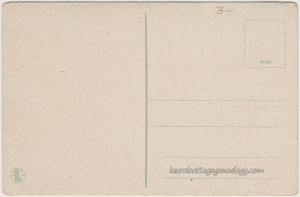597. Une oasis. Un oasi.
Unused, divided back postcard depicting a desert oasis scene. The postcard’s stamp box contain the letters HUGF. The publisher’s logo on the bottom left consists of the letters LLT with a design on each side of the letters similar to an “equals” sign, (=) all of which are enclosed in a circle.
This postcard was very interesting to research. The stamp box, which was a major puzzler at first, became the key to identifying the location for this postcard. Although Hugf could be the name of the printing manufacturer, it does not show up as a company name in online research related to postcards, nor as a translation of “stamp.” However, we do find it as a place name, mentioned in the book entitled “In the Heart of the Desert” by Michael Quentin Morton. This book is a biography on the author’s father, Mike Morton (1924-2003), who was an exploration geologist in the Middle East. Of course, finding the Hugf reference doesn’t mean that this artist rendition of an oasis scene was a real place in the Hugf region, on the other hand, it could very well have been. Chapter 13, page 147 contains a description of the Hugf as an area of ancient rocks situated on the eastern edge of the Jiddat al Harasis plateau.
In the map of Oman above we can see that Jiddat al Harasis is located just below the central region of the map, to the west of the seaside port of Duqm. And if we look for the nation’s capital (top right) we see that the letter “t” in Masqat, and just above that in Matrah, has a type of accent mark similar to the french cedilla. If we look closely at the postcard publisher logo, we can see a similar mark there under the capital T. This might indicate that the publisher was based in the country of Oman.
Sources: http://www.greenmountainpress.co.uk/in_the_heart_of_the_desert_morton.html
http://en.wikipedia.org/wiki/Mike_Morton_%28geologist%29
http://en.wikipedia.org/wiki/Duqm
http://www.nationsonline.org/oneworld/map/oman-map.htm





Leave a Reply